Toss them in a salad, scoop them straight from the skin, or spread some guac on toast — avocados are a great addition to many recipes.
And they’re not just delicious. Avocados are packed with nutrients like vitamin C, potassium, and riboflavin. They’re also full of healthy fats and fibre.
As a bonus for home gardeners, avocado trees can thrive practically anywhere in Australia.
But bear in mind that these trees can take up to 10 years to fruit — or not at all — if grown from a seed.
If you’re hoping for a quicker harvest, start from grafted avocado trees instead!
When to Plant | Growing Conditions | Where to Grow | How to Plant | Care | Harvesting
All About the Avocado Tree

Avocado — or Persea americana — is a tropical evergreen tree best loved for its delicious fruit.
Its native range spans Mexico, Central America, and South America, where it has been used for about 10,000 years.
Before the fruit was called ‘avocado,’ people used to call it ‘alligator pear.’ The fruit’s bumpy, dark green skin looks like an alligator’s hide!
Appearance and growth
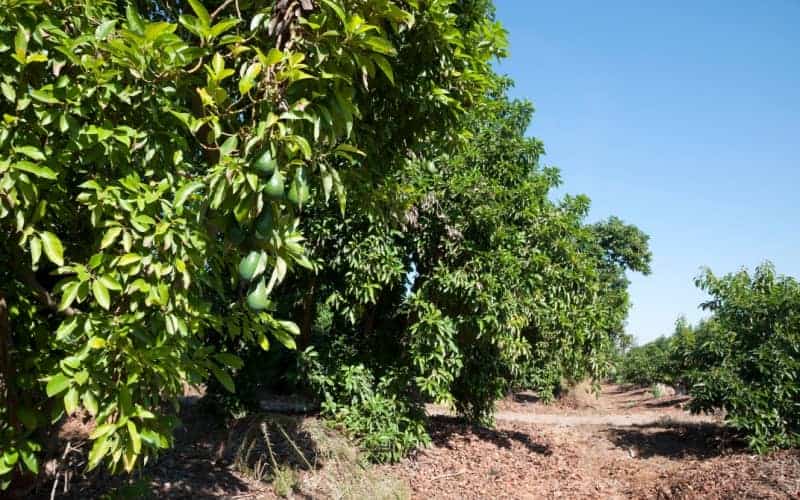
Want to plant your own avocado tree? You might be wondering how big avocados grow or what they look like!
In the right conditions, avocado trees can reach 18m high and 9m wide.
However, there are dwarf types that stay close to 3m tall, which can be grown in smaller spaces or indoors.
Avocado trees vary in form, too. Some varieties grow upright, while others spread out to create a broad canopy.
As the trees grow, you’ll notice the leaves change.
Young avocado trees often have reddish or purplish leaves. As the trees mature, the foliage turns dark green and leathery.
In Australia, avocado trees typically flower in spring (September to November) over 6–8 weeks. They produce clusters of small, yellow-green flowers to prepare for fruit set.
They then start producing fruit after flowering, but how long they keep fruiting depends on the variety.
Fruiting, pollination, and types
Do you need two avocado trees to get fruit? Not always — but it helps!
Avocado tree varieties are either Type A or Type B. The flowers of each type release and receive pollen at different times of the day.
When you plant both types near each other, the timing lines up, which helps them pollinate each other. This can help your avocado trees bear more fruit!
On the other hand, a single tree — or even two of the same type — can still grow some fruit.
After all, insects and the wind can help pollinate avocado flowers. But even so, the yield is usually lower.
Popular varieties
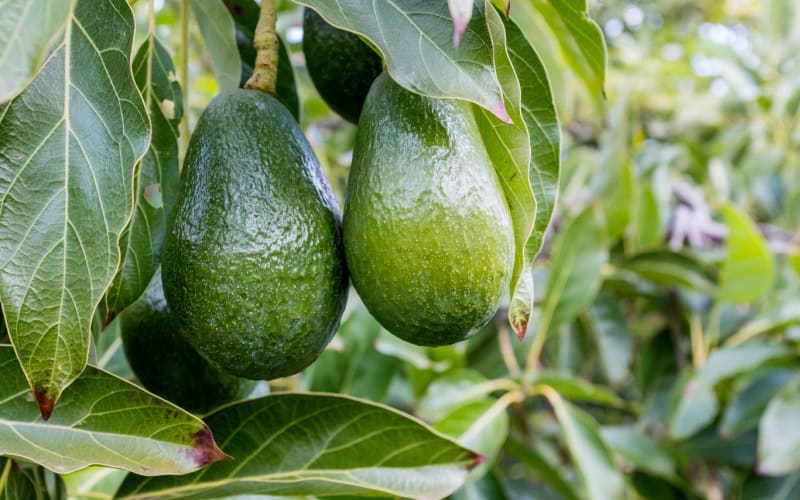
The two most popular avocado varieties in Australia are Hass and Shepard.
Hass is a Type A avocado. Its fruit is a favourite in Australia and around the world, thanks to its rich and creamy flavour.
On the other hand, Shepard is a Type B avocado. It has smooth, glossy skin that stays green even when ripe.
If you’re looking for a compact option, plant the Wurtz avocado, which grows to just about 3–4m tall.
When to Plant an Avocado Tree In Australia
The best time to plant avocado trees in Australia depends on your local climate.
For colder Australian regions, plant avocado trees in spring. This gives the trees enough time to grow strong roots before winter.
For warmer climates, aim to plant avocado trees in early to mid-autumn. The cooler temps will help prevent heat stress on young avocado plants.
Avocado Growing Conditions

With the right conditions, avocados are surprisingly easy to grow!
So wherever you live in Australia, there’s likely an avocado tree that will thrive happily in your backyard.
Climate
Avocados are tropical trees, so they prefer warm temperate to tropical climates. This is why they grow across much of Australia.
QLD and WA are the top commercial producers of avocados.
However, you’ll also see them in colder areas like NSW, SA, VIC, and even TAS. For these regions, cold-tolerant varieties like Bacon and Fuerte are more suitable.
Cold-hardy avocado trees — especially when mature — can handle brief temperature drops to –5°C.
But keep in mind that young trees still need protection from heavy or prolonged frost.
Light

Like other tropical plants, avocados thrive on lots of sunshine.
Plant your avocado tree in a location that gets direct sunlight for 6-8 hours daily.
Soil
Avocado plants grow best in well-draining soil that is slightly acidic to neutral, with a pH between 5 and 7.
They can adapt to most soil types — just not clay, which tends to retain too much water.
Where to Plant an Avocado Tree
Avocados are versatile plants!
You can grow them as shade trees out in the garden, but they also make charming houseplants — particularly the dwarf varieties.
Growing an avocado tree outdoors
When growing an avocado tree outdoors, choose a spot that gets plenty of morning sun but offers some shade from harsh afternoon heat.
Young avocado trees need shelter from strong winds. If your chosen spot is too windy, stake the tree to keep it stable.
Tie the trunk loosely to a sturdy stake and remove it once the tree develops a strong trunk.
For colder regions with heavy frost, cover young avocado trees with a frost cloth to insulate them and prevent damage.
Growing an avocado tree indoors
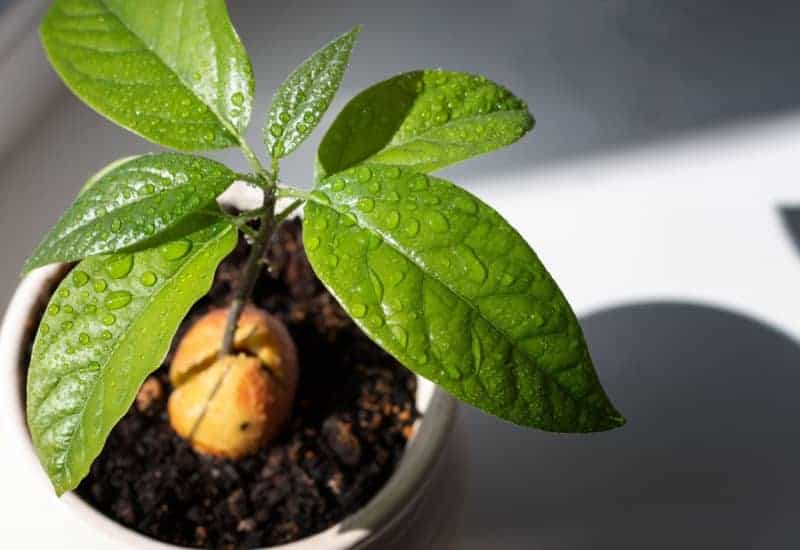
Dwarf avocado trees — like the Wurtz variety — can grow well in a container indoors.
But keep in mind that indoor avocado trees may struggle to bear fruit. If they do, it’s usually less than what you’d get from an outdoor tree.
Place your avocado tree next to a large, sunny window. It needs about 6–8 hours of full sunlight each day. If natural light is limited, consider using a grow light.
Use a pot with drainage holes to prevent waterlogging. A terracotta pot is ideal as it is porous and helps the soil dry more quickly.
If you’re starting with a grafted avocado tree, choose a container that’s just a bit wider and deeper than its original pot.
For seedlings, go for a container about 15-20cm wide and twice as deep as the roots.
Avocado tree roots tend to spread out horizontally so a wide container helps them establish well.
As the avocado tree grows, you’ll need to repot it every 1–2 years. Pick a new pot that’s 5–8 cm wider and slightly deeper.
If the tree outgrows its space, you can prune it to keep the size manageable.
How to Plant an Avocado Tree
So, how to grow an avocado tree? Before you start, be sure to choose the right avocado variety for your local climate.
Once you’ve decided, we recommend transplanting a grafted avocado tree instead of starting from seeds.
Grafted trees are more reliable. They typically start fruiting within 3–5 years and are more likely to give you a high-quality harvest.
Just be sure to plant at least two avocado trees (one Type A and one Type B) about 5–10m apart. This helps with pollination and increases fruit yield.
On the other hand, planting an avocado seed can be fulfilling but a bit of a gamble.
Not all avocado seeds germinate, and even if they do, it can take 10 years or more to produce fruit. Sometimes, seed-grown trees don’t fruit at all!
If they do, the fruit might not resemble the parent avocado. It could be small with a large seed, have poor flavour, or have other undesirable characteristics.
Planting a grafted avocado tree
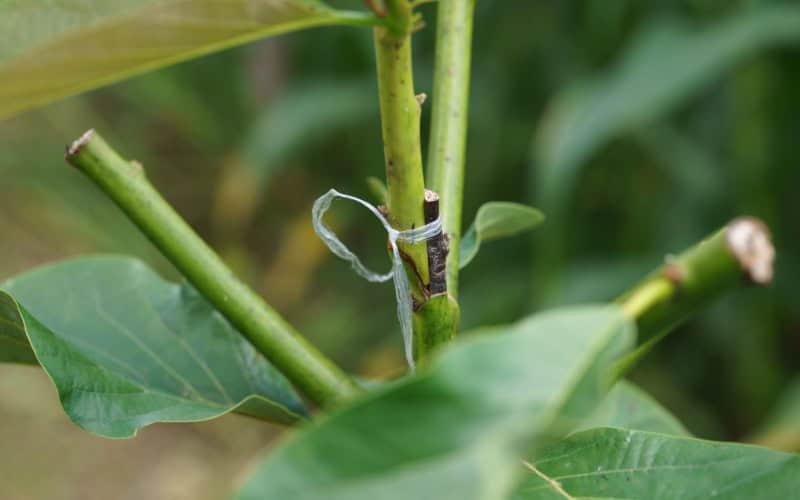
When starting from a graft, be sure to choose a healthy avocado tree.
Ideally, purchase from a garden centre accredited by the Avocado Nursery Voluntary Accreditation Scheme (ANVAS).
This ensures that the avocado tree has been grown under ideal conditions and is free of disease.
When you’re ready to plant, carefully remove the grafted avocado tree from its container. Gently loosen any tangled roots with your hands.
Then, find the graft union. Look for a slightly raised bump or line on the lower trunk of the avocado tree. This is where the top and bottom parts of the avocado tree were joined.
Once you’ve found the graft union, dig a planting hole slightly wider than the avocado tree’s root ball, but no deeper.
Lower the avocado tree into the hole. Make sure that the graft union sits a few centimetres above the soil surface to prevent root rot.
Then, backfill the hole and press it down gently to compact the soil around the tree. Water thoroughly to help the roots settle in.
You can stake your new avocado tree during its first year to help it stay upright while it develops a sturdy trunk.
Planting an avocado seed
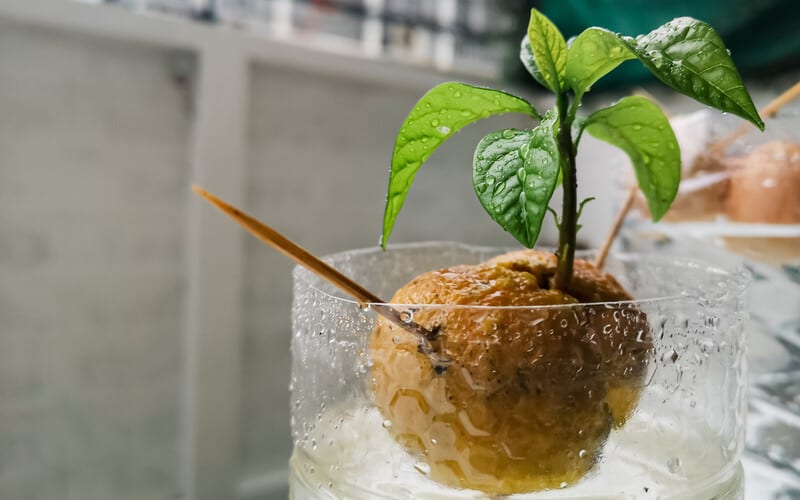
Growing your own avocado plant from a seed (or pit) doesn’t always work. But if it does, it can be incredibly satisfying!
To start, clean the avocado seed and soak it in water to remove any leftover fruit. Be careful not to damage the brown skin.
Find the bottom or the flatter end of the avocado seed. This is where the roots will sprout.
Gently insert three toothpicks evenly around the middle of the seed to form a little scaffold.
Suspend the avocado pit over a glass of water. Make sure that about 3cm of the bottom is submerged. Place the glass somewhere with bright indirect sunlight.
(Alternatively, wrap the seed in a wet paper towel. Keep it in a plastic bag and wait for the roots to sprout before moving the seed to a pot.)
Change the water once a week to prevent bacterial growth. In 2–8 weeks, you should see roots and a sprout start to form.
Once the stem reaches about 15cm tall, plant your avocado seedling in a pot with drainage holes. It should be about 15–20cm wide and twice as deep as the roots.
As you plant the avocado seedling, make sure the roots are fully covered but leave the top half of the seed exposed above the soil surface.
Then, move the pot to a sunny area sheltered from wind.
Once the seedling develops a strong trunk, you can move it to its permanent spot in the garden or indoors.
Caring for Avocado Trees
Give your new avocado tree the care it needs to grow strong and reward you with a great harvest!
Fertilising
Feed young avocado trees with a balanced, slow-release fertiliser every 3–4 months during the growing season. Skip fertilising during the cooler months.
For mature trees, apply a balanced fertiliser 2–3 times a year: before flowering, during fruiting, and again after harvest.
Pruning
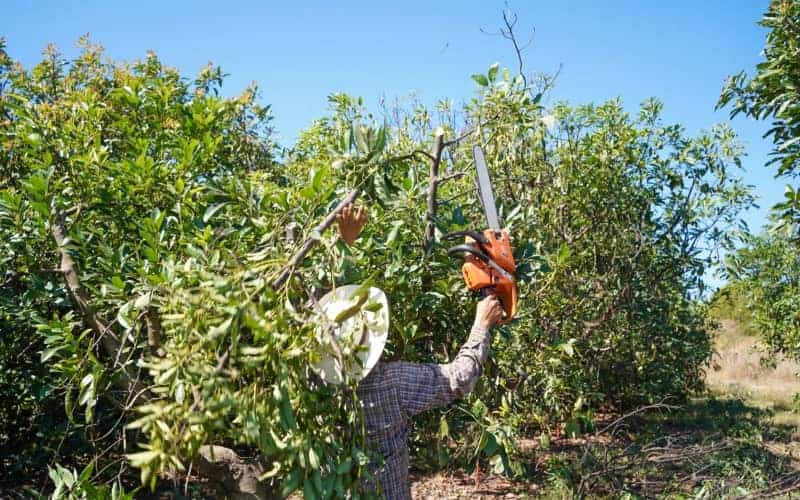
Pruning your avocado tree keeps it to a manageable height and makes picking fruit easier!
It also keeps the tree healthy by letting in more sunlight and air into the canopy.
The best time to prune the avocado tree is in spring, once the risk of frost has passed.
When trimming, do not remove more than a third of the tree’s height or canopy in one go.
For young avocado trees under 3 years, snip off any suckers growing below the graft union. Make clean, angled cuts right at the trunk.
If any upright branches reach around 60cm, cut them away too. This trains the avocado tree to grow out from the sides.
For mature avocado trees, prune lightly every year. Cut away any dead or damaged branches, plus any that are crossing or rubbing against each other.
Every few years, consider a renewal prune. Create windows or openings in the canopy to improve air flow and allow sunlight to reach the inner branches and leaves.
If your tree is too tall or wide, don’t hesitate to call in a local gardening expert to make pruning safer and easier!
Watering
Avocado trees prefer deep but infrequent watering, which helps them develop strong roots.
While the tree is young, keep the soil consistently moist and water when the top 5cm feels dry. In winter, cut back on watering to avoid root rot.
Mature avocado trees also like deep watering. Water slowly around the base and out to the drip line, or the area directly below the outermost edges of the tree.
This allows the moisture to reach the deeper roots.
Let the soil dry out slightly between waterings to keep the avocado tree roots healthy.
Common problems
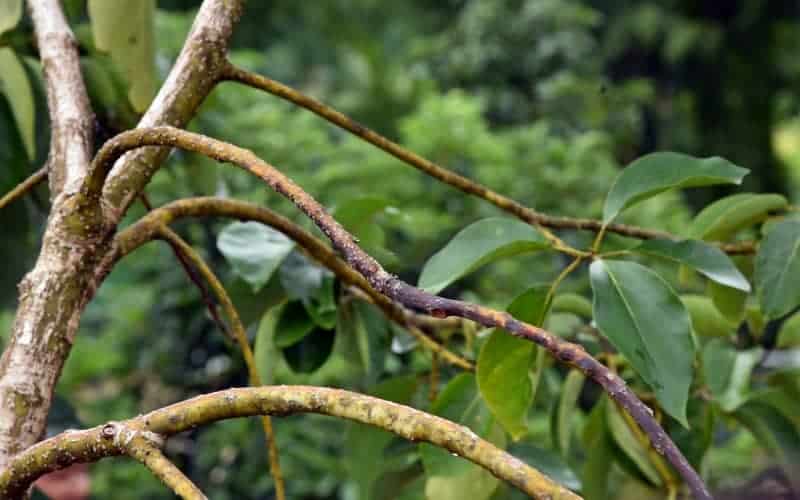
Most avocado problems are caused by overwatering and overly humid conditions.
These can lead to fungal diseases like:
- Stem end rot: Causes dark spots or rot on the stem end of the fruit
- Root rot: Causes root damage, yellowing leaves, wilting, and tree death
- Anthracnose: Causes dark spots on leaves, branches, and ripening fruit
To prevent fungal issues, avoid overwatering and prune the avocado tree regularly. Natural fungicides can also help.
Avocados are also vulnerable to sunblotch viroid, a virus-like pathogen that causes red or yellow discolouration in the bark and fruit.
Unfortunately, there’s no cure for sunblotch — infected avocado trees should be removed to prevent it from spreading.
Pests like aphids, fruit flies, and scale insects may also target your tree and damage young fruit.
Prune any infested areas, then spray the remaining foliage with a mix of ½ tablespoon neem oil, 1L water, and a few drops of dish soap.
Harvesting Avocados
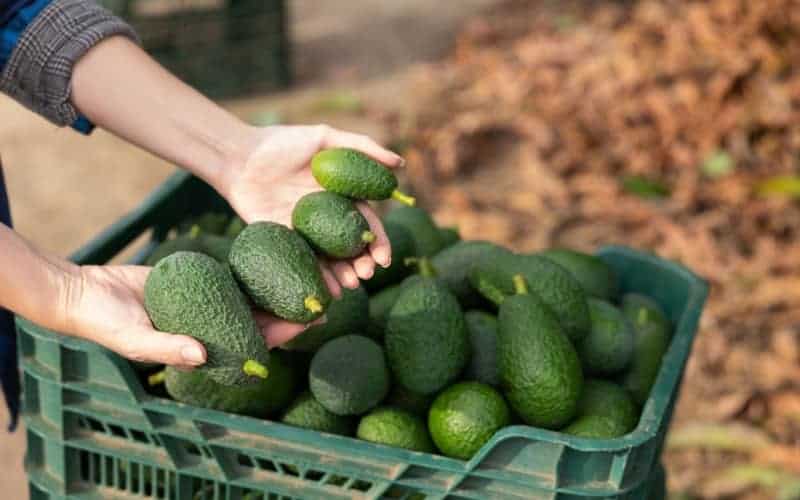
Grafted avocado trees usually take 3–4 years before starting to fruit, while seed-grown ones can take much longer.
Once your tree fruits, it’s important to know when and how to harvest your avocados!
TIP: Help your avocado bear fruit by planting another tree nearby or feeding it with the right fertiliser!
[H3] When do avocado trees fruit in Australia?
Avocado trees fruit at different times across Australia, depending on the variety and where they’re grown.
Hass avocados are in peak season from May to January, while Shepard avocados are typically harvested between February and April.
[H3] When to pick avocados
Avocado fruits mature at different times of the year, depending on the variety and local climate.
They don’t ripen on the tree, so it’s important to spot when they’re ready to pick.
Watch for signs that the avocado fruit is mature. The fruit should feel full and firm, and the skin may start to lose its glossy look.
To check, pick a few test fruits. Use clean pruning shears to snip the avocado from the branch, leaving about 2–5cm of stem attached.
If the avocados ripen within 7–12 days without shrivelling and have a nice flavour (not watery), it’s time to harvest!
[H3] How to pick avocados
Never pick avocados when they’re wet from rain or dew to prevent postharvest rot.
For your safety, use a sturdy ladder when picking your avocados and a large basket to collect the fruit.
Follow the same steps as you did with the test fruits. Use clean, sharp shears to snip the stem, and do not snap the fruit off to avoid damaging the skin and flesh.
Handle avocados gently as they bruise easily during picking.
FAQs: More About Avocados
Here’s the scoop on all things avocado!
What can you plant with avocado trees?
Some great companion plants for avocado trees include:
How deep do avocado tree roots grow?
Avocado trees have a shallow root system — most of the roots grow within the top 15–30cm of soil.
Instead of growing deeper, the roots spread out horizontally and absorb most of the nutrients they need from the upper layers of soil.
It’s best to plant your avocado tree about 8–10m away from houses, driveways, and sidewalks.
This keeps the roots undisturbed and helps prevent any damage to nearby structures.
What is the lifespan of an avocado tree?
Avocado trees can live for up to 400 years.
However, they usually produce fruit only during the first 20–30 years of their life.
Are avocados safe for pets?
If you’re planting an avocado tree and have pets, it’s important to know that avocados can be harmful to animals.
The fruit, leaves, and pit all contain persin, a natural fungicidal toxin.
Some animals — like dogs — may be more tolerant to persin, but it’s best to keep avocados away from all animals to avoid any risks!

